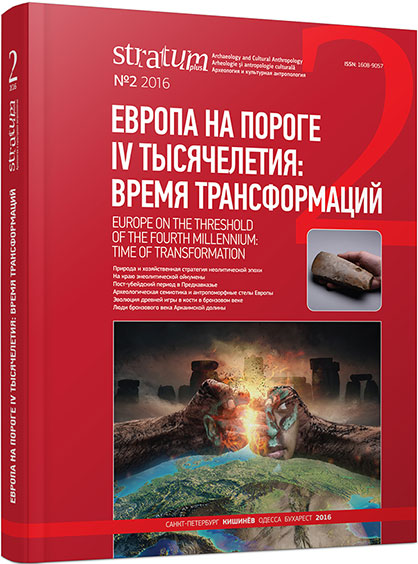О китайских неолитических корнях оленных камней монголо-забайкальского стиля и их социально-семантической интерпретации
On the Chinese Neolithic Roots of Stag Stones of Mongolian-Trans-Baikal Style and Their Social and Semantic Interpretation
Author(s): Andrey V. VarenovSubject(s): History, Archaeology, Cultural history, Social history, Ancient World
Published by: Издательский дом Stratum, Университет «Высшая антропологическая школа»
Keywords: China; Mongolia; Siberia; Neolithic; Zhaobaogou; Hongshan; Majiayao; Banshan-Machang cultures; stag-stones (deer stones); origin; semantics
Summary/Abstract: Stag stones (or deer stones) are vertical stelae, representing highly stylized sculptures of warriors. Many stelae are all covered with images of deer, which explains their name. All stag stones are divided into three types (styles): I — Mongolian-Trans-Baikal, II — Sayano-Altai, III — All-Eurasian. Stag stones are spread mainly in Central and Western Mongolia and in adjacent regions of Russia and China in the first half of the I millennium BC. In search of the possible origin of the culture of stag stones the author referred to the survey of Chinese pottery. For the Chinese Zhaobaogou Neolithic culture were specific zun pottery vessels decorated with deer-headed dragon-like creatures with very long bent bodies, resembling deer from Mongolian-Trans-Baikal stag stones. Hongshan Neolithic culture had yielded quite a number of ceramic human figurines. Anthropomorphic pottery vessels of Majiayao and Banshan-Machang Neolithic cultures had some decorative elements resembling those of stag-stones. Zhaobaogou culture also had a real anthropomorphic sculpture made both in ceramics and in stone. Zun vessels with images of two deer-dragons could be symbols of dual-clan organization of the society. The discovery of four vessels with two different deer-dragons on each in one Neolithic dwelling reflects a more complex social structure with division of ancient society into four fratrial parts each of which had a dual-clan organization.
Journal: Stratum plus. Археология и культурная антропология
- Issue Year: 2016
- Issue No: 2
- Page Range: 195-211
- Page Count: 17
- Language: Russian
- Content File-PDF

